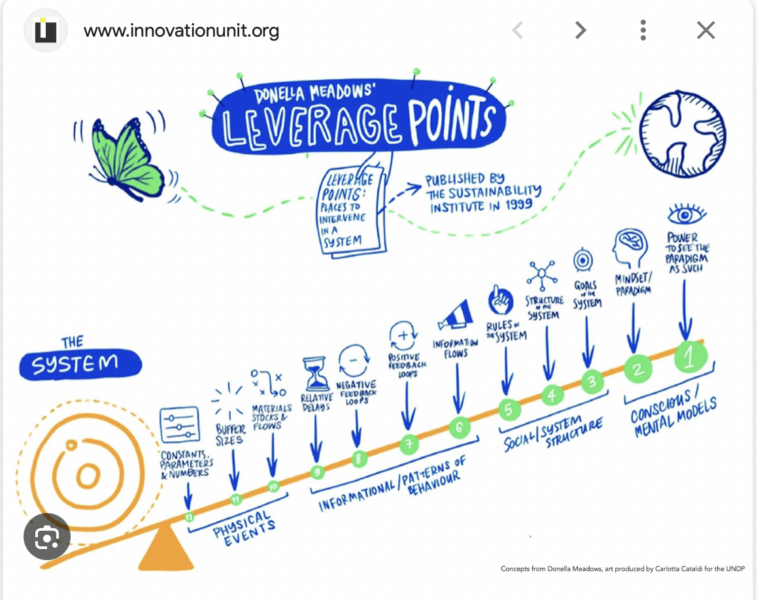Why it is important to understand systems?
Humankind is used to solving problems as if the world was a mechanical machine, by breaking things down, taking parts out of context and finding quick rational solutions.rnrnThis can make operations seem efficient, but, without systemic approach, our solutions often also produced negative externalities, and they often don’t fix the underlying problem. u003cspan style=u0022font-weight: 400;u0022u003eFor example, agriculture that provides us food in one place causes excess nutrients to flow to waterways, which, in its turn, decreases the amount of fish and decreases the available food. u003c/spanu003eSocial media, was at first, a wonderful solution that connected us together.rnrnHowever, over time, we learned that its side effects are severe, and that in some ways it separates us rather than connects. In 2023, the World Economic Forum warned in its annual u003ca href=u0022https://www3.weforum.org/docs/WEF_Global_Risks_Report_2023.pdfu0022u003eGlobal Risks reportu003c/au003e that the world was on the brink of a polycrisis; interconnected crises in several areas, including climate change and biodiversity loss, but also erosion of social cohesion, large scale involuntary migration, and spread of infectious diseases.rnrnSystems thinkers (see sub-chapter u003ca href=u0022https://divingintoradicalcreativity.aalto.fi/sub-chapter/systems-thinking-and-sensing/u0022u003e4.3, Systems thinking and sensingu003c/au003e) are calling for challenging the existing assumptions and perspectives on what works well and what needs to be changed. For radical creativity to really change the world, it too needs to work on a systemic level. u003cstrongu003eSystemic changeu003c/strongu003e also calls for radically creative transformation of many things, including ourselves, our ways of thinking and relating to each other.rnrnu003cspan style=u0022font-weight: 400;u0022u003eWu003c/spanu003eu003cspan style=u0022font-weight: 400;u0022u003ee’ll first discuss what systemic impact is and then we’ll introduce a framework of the essential elements needed in changing how we think about what’s normal in our lives and how to gradually enable u003c/spanu003esystemic changeu003cspan style=u0022font-weight: 400;u0022u003e.u003c/spanu003e
Reflection
How do you understand systems approach?
Well done! You have successfully completed this assignment.
Networks of transformation
It’s a creative team sport
u003cspan style=u0022font-weight: 400;u0022u003eThe systems that we are talking about are not stable but always changing. They are also in many ways unknown – think of a human body, which science still doesn’t know completely. This is why systemic change can be taken forward by experimentation and by learning from real-life situations – like in developing a new pharmaceuticals. It is often impossible to determine in advance what will ultimately result in change and what success will look like. Essential to systemic work is the idea that there is always a certain amount of disorder and chaos in the system. u003c/spanu003eu003cspan style=u0022font-weight: 400;u0022u003ernu003c/spanu003eu003cspan style=u0022font-weight: 400;u0022u003ernu003c/spanu003eu003cspan style=u0022font-weight: 400;u0022u003eSystemic change can happen through art, as it creates new ways of experiencing, can change us deeply, and can carry new ideas in easily spreading aesthetic forms – think of 1960’s peace movements music, for example. Also business ideas, innovative products and social innovations, as well as activism can initiate change. u003c/spanu003ernrnAn important tools for systems change is creating a supportive environment—or u0022holding spaceu0022—where people with different perspectives can come together. This is about how we interact as a group, balancing shared rules with the behaviors of individuals and the community.rnrnu003cspan style=u0022font-weight: 400;u0022u003eIncreasingly, achieving systemic impact is about relying on and facilitating the interaction of social networks. A collective inspiration about something that is going to happen in the near future, anticipating the future, is also at the heart of radical creativity.u003c/spanu003e
Case study
Academy of Moving People
Well done! You have successfully completed this assignment.
Leverage points
What are the most powerful ways to impact the whole system?
u003cspan style=u0022font-weight: 400;u0022u003eThe concept of ‘leverage points’ developed by Donella Meadows (1999, 2008) is useful to describe how a small shift in one thing can produce big changes in everything. u003c/spanu003ernrnu003cspan style=u0022font-weight: 400;u0022u003eLeverage points are ways to change the system. Shallow leverage points relate to material aspects of systems such as incentives like different social benefits, and resource flows, like the flow of money, or electricity. Deep leverage points are the way the system is organized, its rules and structures, for example the laws. At the deepest level, leverage points are the fundamental u003cspan data-olk-copy-source=u0022MessageBodyu0022u003ebeliefs, values, ideologies and world viewsu003c/spanu003e behind the systems. u003c/spanu003ernrnu003cspan style=u0022font-weight: 400;u0022u003eChanging the rules and structures of a system is important, but changing the deeper mindsets behind those rules can lead to even greater and more meaningful changes. Currently, in efforts to create change, emphasis is often on the less impactful, shallow leverage points. u003c/spanu003eu003cspan style=u0022font-weight: 400;u0022u003e(Woiwode ym. 2021)u003c/spanu003ernrnIn detail, Meadows identified 12 leverage points to change a system. Here they are, from least to most efficient :rnrn12. Constants, parameters, numbers (such as subsidies, taxes, standards)rn11. Size of buffers and other stabilizing stocks (such as inventories and financial savings)rn10. Structure of material stocks and flows (such as transport networks, population age structures).rn9. The lengths of delays (for example how long it takes to build a new energy plant)rn8. The strength of negative feedback loops (for example a thermostat that keeps a room temperature stable, or market prices that stabilize demand and supply)rn7. The gain around driving positive feedback loops (for example interest that increases the more money there is)rn6. The structure of information flows (who does and does not have access to information).rn5. The rules of the system (such as incentives, punishments, constraints).rn4. The power to add, change, evolve, or self-organize system structure (such as nature, or a rich and dynamic cultural scene)rn3. The goals of the system (such as GDP growth)rn2. The mindset or paradigm out of which the system — its goals, structure, rules, delays, parameters — arises (including beliefs, values, ideologies, world views)rn1. The power to transcend paradigms (Let go into not knowing, or into what the Buddhists call enlightenment)

Quiz
Well done! You have successfully completed this assignment.
Systemic impact
How to predict systemic impact?
u003cspan style=u0022font-weight: 400;u0022u003eSystemic intervention with, for example, a product, social innovation or art u003c/spanu003eu003cspan style=u0022font-weight: 400;u0022u003emay have unintended widespread effects on the initial beneficiaries and players outside the immediate ecosystem. So, it is close to impossible to understand the complexity of the consequences of a radically creative idea. Yet, to some degree, its systemic impact can be anticipated, from three perspectives: the u003c/spanu003eu003cbu003einterconnectedness u003c/bu003eu003cspan style=u0022font-weight: 400;u0022u003eof the parts of the immediate system, the u003c/spanu003eu003cbu003espread of changeu003c/bu003eu003cspan style=u0022font-weight: 400;u0022u003e, and the u003c/spanu003eu003cbu003eresilience and adaptability u003c/bu003eu003cspan style=u0022font-weight: 400;u0022u003eof the affected systems (Schmidt-Abbey et al., 2022, Janssen et al., 2022, Reynolds et al., 2016).u003c/spanu003ernrnu003cspan style=u0022font-weight: 400;u0022u003eFirst, u003c/spanu003eu003cbu003einterconnectednessu003c/bu003eu003cspan style=u0022font-weight: 400;u0022u003e assumes that the direct users and stakeholders of radically creative outcomes do not exist in isolation. Rather, they interact with and influence other parts of the system. Evaluating the systemic impact at the individual-to-individual level of interconnectedness is about finding ways to understand how the first adopters of a radically creative outcome, in one part of the system, could influence other participants in the same system.u003c/spanu003ernrnu003cspan style=u0022font-weight: 400;u0022u003eSecond, the systemic impact of a radically creative outcome can be observed at a larger scale when we acknowledge the existence of a u003c/spanu003eu003cbu003esystems hierarchyu003c/bu003eu003cspan style=u0022font-weight: 400;u0022u003e. Entrepreneurial and innovative products are parts of economic systems, which are parts of societal systems, and all societies exist on the ecological system of planet Earth (Midgley u0026amp; Lindhult, 2017).u003c/spanu003ernrnThus, to anticipate the potential for widespread change, we might want to start by examining the interdependencies between directly connected systems and gradually move to links with remote systems like distant communities, industries, and even systems across countries. For instance, assuming you work in an organization where you and your team have come up with a radically creative solution to a sustainable future, the directly connected system may be the communications department. A more remote system would be another individual from your network who works and lives in another country and who is inspired by your actions to kick-start their radically creative initiative.rnrnu003cspan style=u0022font-weight: 400;u0022u003eThird and last, understanding systemic impact involves assessing how systems might respond and adapt to radically creative outcomes. This observation of u003c/spanu003eu003cbu003esystemic resilienceu003c/bu003eu003cspan style=u0022font-weight: 400;u0022u003e and u003c/spanu003eu003cbu003eadaptabilityu003c/bu003eu003cspan style=u0022font-weight: 400;u0022u003e includes examining whether radical change reflected in activism, entrepreneurship or innovation enhances the resilience of systems or introduces vulnerabilities.u003c/spanu003e
Real-life activity
Be an activist
Well done! You have successfully completed this assignment.
Keywords
u003cstrongu003eKeywords: u003c/strongu003eu003cspan style=u0022font-weight: 400;u0022u003esystemic impact, systemic change, systemic, systemic challenges, stakeholder, systemic change, sustainability, social innovation, value creation, value distribution, interconnectedness, systems hierarchy, systemic resilience, systemic adaptability, stakeholder, personal agency, collective agency, transformative agency, expansive learning.u003c/spanu003ernrnu0026nbsp;
u003ch3u003eu003cstrongu003eReferencesu003c/strongu003eu003c/h3u003ernu003cspan style=u0022font-weight: 400;u0022u003eBandura, A. (2006). Toward a psychology of human agency. u003c/spanu003eu003ciu003eu003cspan style=u0022font-weight: 400;u0022u003ePerspectives on psychological scienceu003c/spanu003eu003c/iu003eu003cspan style=u0022font-weight: 400;u0022u003e, u003c/spanu003eu003ciu003eu003cspan style=u0022font-weight: 400;u0022u003e1u003c/spanu003eu003c/iu003eu003cspan style=u0022font-weight: 400;u0022u003e(2), 164-180.u003c/spanu003ernrnu003cspan style=u0022font-weight: 400;u0022u003eEngeström, Y. (2007). Enriching the theory of expansive learning: Lessons from journeys toward coconfiguration. u003c/spanu003eu003ciu003eu003cspan style=u0022font-weight: 400;u0022u003eMind, culture, and activityu003c/spanu003eu003c/iu003eu003cspan style=u0022font-weight: 400;u0022u003e, u003c/spanu003eu003ciu003eu003cspan style=u0022font-weight: 400;u0022u003e14u003c/spanu003eu003c/iu003eu003cspan style=u0022font-weight: 400;u0022u003e(1-2), 23-39.u003c/spanu003ernrnu003cspan style=u0022font-weight: 400;u0022u003eEngeström, Y., u0026amp; Sannino, A. (2017). Studies of expansive learning: Foundations, findings and future challenges. u003c/spanu003eu003ciu003eu003cspan style=u0022font-weight: 400;u0022u003eIntroduction to Vygotskyu003c/spanu003eu003c/iu003eu003cspan style=u0022font-weight: 400;u0022u003e, 100-146.u003c/spanu003ernrnu003cspan style=u0022font-weight: 400;u0022u003eKerosuo, H. (2017). Transformative agency and the development of knotworking in building design. u003c/spanu003eu003ciu003eu003cspan style=u0022font-weight: 400;u0022u003eAgency at work: An agentic perspective on professional learning and developmentu003c/spanu003eu003c/iu003eu003cspan style=u0022font-weight: 400;u0022u003e, 331-349.u003c/spanu003ernrnu003cspan style=u0022font-weight: 400;u0022u003eJanssen, M. J., Bergek, A., u0026amp; Wesseling, J. H. (2022). Evaluating systemic innovation and transition programmes: Towards a culture of learning. u003c/spanu003eu003ciu003eu003cspan style=u0022font-weight: 400;u0022u003ePLoS sustainability and transformationu003c/spanu003eu003c/iu003eu003cspan style=u0022font-weight: 400;u0022u003e, u003c/spanu003eu003ciu003eu003cspan style=u0022font-weight: 400;u0022u003e1u003c/spanu003eu003c/iu003eu003cspan style=u0022font-weight: 400;u0022u003e(3), e0000008.u003c/spanu003ernrnu003cspan style=u0022font-weight: 400;u0022u003eMidgley, G., u0026amp; Lindhult, E. (2017). What is systemic innovation?. Center for Systems Studies, Research Memorandum 99, pp. 1-39.u003c/spanu003ernrnu003cspan style=u0022font-weight: 400;u0022u003eReynolds, M., Gates, E., Hummelbrunner, R., Marra, M., u0026amp; Williams, B. (2016). Towards systemic evaluation. u003c/spanu003eu003ciu003eu003cspan style=u0022font-weight: 400;u0022u003eSystems Research and Behavioral Scienceu003c/spanu003eu003c/iu003eu003cspan style=u0022font-weight: 400;u0022u003e, u003c/spanu003eu003ciu003eu003cspan style=u0022font-weight: 400;u0022u003e33u003c/spanu003eu003c/iu003eu003cspan style=u0022font-weight: 400;u0022u003e(5), 662-673.u003c/spanu003ernrnu003cspan style=u0022font-weight: 400;u0022u003eSchmidt-Abbey, B., Reynolds, M., u0026amp; Ison, R. (2020). Towards systemic evaluation in turbulent times–Second-order practice shift. u003c/spanu003eu003ciu003eu003cspan style=u0022font-weight: 400;u0022u003eEvaluationu003c/spanu003eu003c/iu003eu003cspan style=u0022font-weight: 400;u0022u003e, u003c/spanu003eu003ciu003eu003cspan style=u0022font-weight: 400;u0022u003e26u003c/spanu003eu003c/iu003eu003cspan style=u0022font-weight: 400;u0022u003e(2), 205-226.u003c/spanu003ernrnu003cspan style=u0022font-weight: 400;u0022u003eSchwartz Cowen, R., (1985). u003c/spanu003eu003ciu003eu003cspan style=u0022font-weight: 400;u0022u003eMore Work for Motheru003c/spanu003eu003c/iu003eu003cspan style=u0022font-weight: 400;u0022u003e. Basic Books.u003c/spanu003e
5. Vaikutus
In this chapter, we explore how radical creativity impacts our lives, both individually and as a society, by bringing about significant changes for the better.
1.5 Value of radical creativity
You’ll get a broader perspective on the economic value of radical creativity and why it pays off to develop a radically creative mindset.
1.4 Stories of pursuing radical creativity
You’ll get a view of some Aalto University endeavors, where radical creativity is sought for.
2.5 Creativity and wellbeing
You’ll explore three avenues for expressing creativity: tackling challenges in work contexts, experimenting with creative identity, and self-actualization.
2.4 Cultivating a creative identity
You’ll gain insights into four types of creative identities: artistic, abstract ideas, entrepreneurial and empowering.
2.3 Curiosity and critical thinking
You’ll learn how identifying challenges can drive radically creative outcomes through curiosity, imagination and critical thinking.

 Nice! You have completed the activity successfully.
Nice! You have completed the activity successfully.